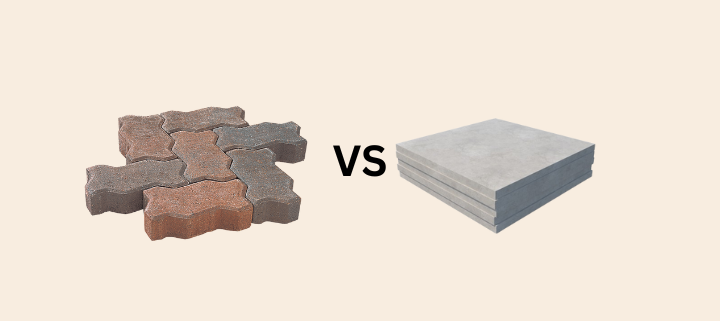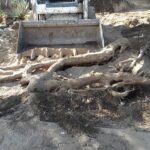Pavers vs. Concrete Slab: Which One Is Right for You?
Looking to upgrade your outdoor space but unsure whether to use pavers or a concrete slab?
Both offer durability and style, but the choice depends on cost, maintenance, and appearance. Pavers bring flexibility and easy repairs, while a slab provides a smooth, budget-friendly surface. Let’s explore the details to help you decide.
What Are Pavers?
Pavers are individual units, often made from stone, brick, or concrete, arranged in a specific pattern. These small blocks fit together tightly, forming a sturdy walking or driving surface. They come in various colors, shapes, and textures, offering plenty of choices for customization.
Benefits of Pavers
Visual Appeal
With a wide range of styles, pavers allow for creative designs. The ability to mix different colors and patterns provides flexibility in achieving a unique look.
Durability
Pavers hold up well under weight and movement. Because they consist of separate pieces, minor shifts in the ground do not cause major cracks or damage.
Easy Repairs
If one section experiences wear or damage, replacement is simple. Only the affected pieces need to be removed and swapped with new ones, preventing large-scale repairs.
Slip Resistance
Many paver materials provide natural traction, reducing the chance of slipping, especially when wet.
Drainage
Small gaps between the pieces allow rainwater to seep through rather than pooling on the surface. This feature helps in areas prone to heavy rainfall.
Drawbacks of Pavers
Installation Time
Placing each unit takes longer than pouring a single slab. Proper preparation, including leveling the ground and adding a stable base, adds to the process.
Weed Growth
Over time, grass or weeds may sprout between the sections, requiring occasional maintenance.
Cost
The price of materials and labor tends to be higher than that of a single concrete slab. The investment pays off in durability and appearance, but the upfront cost can be a concern.
What Is a Concrete Slab?
A concrete slab is a continuous, solid surface formed by pouring liquid concrete into a prepared area. Once set, it becomes a firm and long-lasting foundation. Typically used for patios, driveways, and sidewalks, this option provides a smooth and strong base for everyday use.
Benefits of Concrete Slabs
Quick Installation
Pouring and leveling take less time compared to placing individual blocks. Once dried, the surface is ready for use.
Lower Initial Cost
The materials and labor required are usually more affordable than pavers. For those on a budget, this can be an attractive choice.
Minimal Weed Growth
Since the surface is solid without gaps, unwanted plants do not have space to grow.
Strong and Long-Lasting
When properly installed, a slab can support heavy loads and last for many years without major issues.
Drawbacks of Concrete Slabs
Cracking Over Time
Changes in temperature, pressure, and ground movement may cause cracks to develop. Fixing these issues often requires significant work.
Limited Design Options
While some decorative finishes and colors are available, slabs do not offer as much variety as pavers.
Slippery When Wet
A smooth surface can become slick in rainy conditions unless a textured finish is applied.
Difficult Repairs
If damage occurs, fixing a slab often involves cutting or replacing large sections, which can be costly and time-consuming.
Which Option Suits Your Needs?
1. Installation Process
Pavers
- Requires ground preparation, including excavation, leveling, and adding a base layer.
- Each piece must be placed individually, which takes time and precision.
- May involve sealing the gaps with sand to prevent shifting.
Since pavers consist of separate pieces, installation takes longer than pouring a concrete slab. The ground must be carefully prepared to ensure stability, and each unit must be placed by hand. While labor-intensive, the result is a durable surface that adapts well to ground movement.
Concrete Slab
- Involves framing the area, pouring liquid concrete, and leveling the surface.
- Dries within a few days but may need additional curing time for full strength.
- Faster installation compared to pavers.
A slab provides a quicker solution since the material is poured in one go. After setting, it forms a solid foundation suitable for heavy use. While less complex than installing pavers, proper reinforcement is necessary to prevent future cracks.
2. Durability and Strength
Pavers
- Withstands heavy loads without cracking.
- Small shifts in the ground do not cause significant damage.
- Can last decades with proper care.
Pavers excel in durability because their separate units allow flexibility. If the ground moves slightly, individual pieces adjust without breaking. This feature makes them a great option for areas prone to shifting soil or temperature changes.
Concrete Slab
- Strong and capable of supporting heavy weight.
- Prone to cracking if the ground shifts or expands.
- Can last for decades with sealing and maintenance.
While a slab is highly durable, cracks may develop over time due to weather changes or ground movement. Reinforcement techniques like rebar or expansion joints can help, but repairs may require cutting out damaged sections.
3. Cost
Pavers
- Higher upfront cost due to labor and materials.
- Individual repairs are affordable since only damaged sections need replacement.
- Long-term value is high due to durability and repair flexibility.
The initial price of pavers is usually higher than a slab, but maintenance costs remain low. If damage occurs, replacing only the affected pieces is simple, making it a cost-effective choice in the long run.
Concrete Slab
- Lower initial cost for materials and labor.
- Repair costs can be high if cracks develop.
- Sealing or resurfacing may be needed over time.
A slab is the more budget-friendly option at first, but potential cracking and repairs can add expenses over time. Regular sealing helps extend its lifespan and maintain appearance.
4. Maintenance and Repairs
Pavers
- Individual pieces can be replaced easily if damaged.
- May require occasional re-leveling if ground shifts.
- Weeds can grow between gaps, needing periodic cleaning.
Pavers require some upkeep, such as refilling gaps with sand to prevent movement and removing weeds that may sprout between pieces. Despite this, repairs remain simple and cost-effective.
Concrete Slab
- Cracks are difficult to repair without replacing sections.
- Can develop stains that require cleaning or resurfacing.
- Needs sealing to prevent moisture damage.
Once a slab cracks, fixing it can be costly and time-consuming. Stains from oil or water may also require professional cleaning or resurfacing to restore the original look.
5. Appearance and Customization
Pavers
- Available in various shapes, colors, and patterns.
- Can be arranged in creative designs.
- Adds a high-end, elegant look to outdoor spaces.
Pavers provide endless design possibilities, allowing homeowners to create unique patterns and match specific styles. Whether aiming for a modern or rustic look, pavers offer greater customization options.
Concrete Slab
- Limited color and pattern choices.
- Can be stamped or stained for a decorative look.
- Simpler and more uniform in appearance.
While a slab does not offer as much design flexibility as pavers, decorative techniques such as stamping or staining can enhance its look. For those preferring a clean, minimal style, a slab works well.
6. Weather and Drainage Performance
Pavers
- Small gaps between pieces allow water to drain naturally.
- Less likely to form puddles or slippery surfaces.
- Handles freezing and thawing cycles well.
Because pavers have natural gaps, rainwater drains more efficiently, reducing puddles and minimizing slip hazards. In colder climates, they perform well against freeze-thaw cycles, preventing major cracking.
Concrete Slab
- Requires proper slope for drainage.
- Can become slippery when wet.
- Expands and contracts with temperature changes, leading to cracks.
A slab needs a well-planned slope to direct water away, or pooling can occur. In wet conditions, the surface may become slick unless textured finishes are applied. Expansion and contraction from temperature changes can also cause cracks over time.
Final Decision
Choose pavers if customization, easy repairs, and durability are top priorities. Pick a concrete slab if cost, quick installation, and a smooth surface matter most.
Both materials create strong and attractive surfaces. Personal preferences, budget, and climate conditions will determine the best choice.



